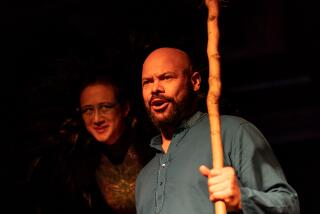Not Just a Plot, but a Passion to Find Art, History and Beauty in Cemeteries
- Share via
Some of the most moving cities in the world are cities of the dead, worth a traveler’s time for their art and history and the respite they provide as islands of green in the middle of strident modern cities of the living.
I think fondly of Sleepy Hollow Cemetery, on a hill overlooking Concord, Mass., with the graves of Louisa May Alcott and Henry David Thoreau; the atmospheric above-ground graveyards of New Orleans, such as St. Louis Cemetery near the French Quarter; and Arlington National Cemetery, across the Potomac River from Washington, D.C., a fine place to see the cherry blossoms in spring.
Above all, I recall riding a bike in the rain several years ago to Pere Lachaise in Paris, a French who’s who of a cemetery with the graves of Edith Piaf, Yves Montand, Colette, Georges Seurat, Frederic Chopin, Oscar Wilde and Jim Morrison of the Doors.
“To be buried in Pere Lachaise,” Victor Hugo once said, “is like having mahogany furniture.”
The bike ride wasn’t particularly pleasant in heavy traffic, but the rain was perfect. Once I walked through the gate, I was in another world.
Everything smelled of wet leaves and old stone, and the tombs were spectacularly lugubrious, decorated with cracked ivy-draped urns, hands reaching out of the grave and mossy weeping angels.
My friend Linda Yellin loves Pere Lachaise, where she always wanders aimlessly. It inspired Katie Karrick, a Cleveland cemetery historian who writes the newsletter “Tomb With a View,” and it spurred Judi Culbertson to become co- author of guidebooks on the cemeteries of London, Paris, Italy, California and New York (published by Walker & Co.).
Karrick says Pere Lachaise started a reform movement in 19th century America that replaced dour old Colonial burial grounds with lushly sculpted melancholy cemeteries, landscaped like English gardens. In the Victorian age, Pere Lachaise inspired graveyards in the U.S. such as Mount Auburn in Boston; Mountain View Cemetery in Oakland, designed by Frederick Law Olmsted; and Green-Wood in Brooklyn, with the graves of Currier and Ives and a stunning Gothic Revival gatehouse. They were considered tourist attractions in their own right, visited by photographers, day-trippers and dignitaries.
There’s plenty a traveler can learn or recall at a cemetery. Visiting pioneer burial grounds in California, author Culbertson is struck by the many graves of children, all dating from the same time, suggesting they died during an epidemic.
The Old Jewish Cemetery beside Remuh Synagogue, in the Kazimierz section of Krakow, Poland, has a mosaic-like wall, made of pieces of tombs destroyed during the Nazi occupation. Tourists visit Hollywood Forever Cemetery, in a slightly shabby neighborhood north of Paramount Studios, to pay their respects to Rudolph Valentino, Peter Lorre and Benjamin “Bugsy” Siegel, now all bit players in eternity.
I stopped by Hollywood Forever on a recent Saturday morning. In the flower shop near the front gate, the man who sold me a map told me to have a nice stay, which made us both laugh.
“Cemeteries are really not depressing at all,” says Culbertson. “The people entombed there are happy to have you come.” Culbertson suspects that graveyard visitors often get a little frisson of joy as they scrutinize funerary monuments and think to themselves, “You’re there; I’m not.”
Many travelers visit graveyards for the tombs and epitaphs. “People like me have discovered that cemeteries are filled with beautiful Colonial and Victorian art,” historian Karrick says. “All the major revival styles of architecture are represented there, from Greek to Gothic to Egyptian.”
The epitaphs often are enchanting, “the last communication of the dead with the living,” says Larrian Gillespie, who has mounted a campaign to restore the Victorian cemeteries of Mendocino County in Northern California.
Some epitaphs could put starch in your shirt. Fred Oakley, a member of the Assn. for Gravestone Studies in Greenfield, Mass., has a favorite, often seen in Colonial cemeteries, such as Boston’s Copp’s Hill Burial Ground, founded in 1659:
“Stop and note as you pass by.
“As you are now, so once was I.
“As I am now, so you will be.
“Prepare for death and follow me.”
The graves of famous people also attract visitors. It’s easy to figure out who lies where by using such Internet sites as www.findagrave.com and www.politicalgraveyard.com and books like “The Tombstone Tourist: Musicians,” by Scott Stanton (3T Publishing, 1998).
In my salad days, I made a special trip to Oxford, Miss., to drink bourbon at William Faulkner’s grave. Two years ago I found Frank Sinatra’s resting place in Desert Memorial Park outside Palm Springs, marked by a simple stone engraved with “The Best Is Yet to Come,” a song Ol’ Blue Eyes recorded in 1964.
My most memorable cemetery trip was unplanned. I was walking north of Peterborough, N.H., the classic old New England village that is thought to have inspired “Our Town,” by Thornton Wilder, who worked on the play at the MacDowell Colony, an artists’ retreat nearby. As I crested a hill, I saw a small, dilapidated graveyard surrounded by nothing but sky. I knew in my heart I had found the cemetery that serves as the setting for the last act of “Our Town,” in which Wilder wrote, “An awful lot of sorrow has sort of quieted down up here.”
In the end, maybe that’s what I find by visiting cemeteries far and wide, even when I don’t know or care about the people buried there, a quieting of the nameless sorrows that all travelers carry through life.
More to Read
Sign up for The Wild
We’ll help you find the best places to hike, bike and run, as well as the perfect silent spots for meditation and yoga.
You may occasionally receive promotional content from the Los Angeles Times.






